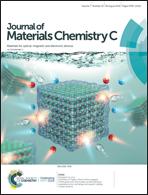Molecular engineering of thermally activated delayed fluorescence emitters to concurrently achieve high performance and reduced efficiency roll-off in organic light-emitting diodes†
Abstract
Thermally activated delayed fluorescence (TADF) emitter based organic light-emitting diodes (OLEDs) utilizing both singlet and triplet excitons are considered as the most promising third-generation technology for lighting and display. Simultaneously high external quantum efficiency and luminance are highly desirable for these practical applications. However, the severe efficiency roll-off at high luminance that is involved with triplet exciton annihilation is a remaining problem for TADF OLEDs, which is mainly related to the reverse intersystem crossing (rISC) from the triplet to the singlet states. To date, the relationship between the rISC process and molecular design of TADF emitters is still unclear, and a rational molecular design strategy to solve this dilemma has not been established. In this study, we propose an approach to design two TADF emitters, m-2SPAc-PPM and o-2SPAc-PPM, with a sterically crowded configuration and strong spin–vibronic coupling. As expected, o-2SPAc-PPM exhibits a krISC as high as 3.55 × 107 s−1, and a short triplet exciton lifetime of 5.36 μs. As a result, the TADF OLEDs based on o-2SPAc-PPM achieved remarkably high external quantum efficiencies (EQEs) of up to 24.8% with a brightness as high as 24 200 cd m−2 and a concurrent significantly reduced efficiency roll-off, which fulfills the requirements for practical high luminance.



 Please wait while we load your content...
Please wait while we load your content...